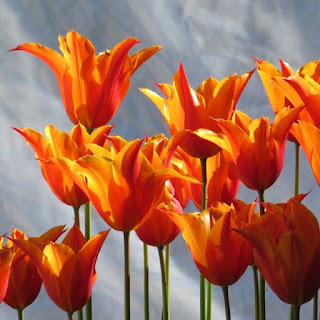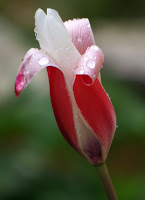"When daisies pied and violets blue
And lady-smocks all silver-white
And cuckoo-buds of yellow hue
Do paint the meadows with delight..."
- Shakespeare
 |
| Would the Bard have known about 'cuckoo-buds' of oil-seed rape? |
What could be finer than setting out on a bright April morning, with the dew wet underfoot and leaves just beginning to unfurl their Spring green?
 |
| Cardamine pratensis Lady's Smock |
Whilst some countryside plants will have changed since Shakespeare's time, many are reassuringly familiar - like the Lady's Smock or Cuckoo Flower on the right, which favours damp meadows and has been much in evidence these past three weeks.
It's common in wetlands throughout Europe and our local variety has a subtle tinge of mauve to its petals.
Certainly it's less obtrusive than the almost fluorescent blooms of rape seed, happily colonising banks and waysides from last year's crop!
 |
| Fumaria officinalis Common Fumitory |
Despite its name of common fumitory, this fragile wildflower is less ubiquitous in our verges and vineyards but rather endearing once you look closely at its little spurred flowers in two-toned pink.
It would be great to find a taller, more stalwart version for the garden but the closest we've come is to grow the cultivated toadflax, Linaria purpurea, which is usually available in purple but can also be found in a pale shell pink; this variety is known as 'Canon Went' and has delicate foliage which easily fits between other stouter plants.
Wildlife
Also full of the joys of Spring, our neighbour's newest donkey - Balthazar - decided to get frisky with his stable-mate, Baladin, who is a Poitou donkey almost twice his size.
Never mind that they're both males, it looked like simple horse-play despite all the biting and at one point little Balthazar ended up square underneath his friend... hours of fun and frolic!
 |
| An elegant Racka ewe poses with her lamb |
Meanwhile, our local lambs have been growing up fast and there seem to be few left to gambol amongst the daisies.
One exception is our neighbour's rare-breed ewe, a Hungarian racka, which has just given birth to a curly-coated lamb with rather coltish legs.
Wikipedia tells us they are a multi-purpose breed, used for milking, wool and for meat, whilst their 'quiet disposition' makes them suitable for amateur
enthusiasts. (Over here, a local lady spins their wool to make some very appealing soft toys.)
Perennials
This year our dicentra has obligingly produced its flowers so that they arch gracefully over the path, catching the early-morning light and creating an irresistible photo.
When you look closely, their blooms appear to be sewn from softly cushioned satin, and that little white drop at the bottom of the 'heart' often holds a bead of moisture, adding to its jewel-like effect.
We also grew a white version of the plant which is pretty but not nearly so eye-catching.
In the background are mounds of white iberis and mauve aubretia which provide useful edging.
One of the best things about early spring is watching the emergence of bright new foliage on perennials which may have become a little ragged and browned-off over winter.
Lychnis is a plant which seeds itself all over the garden and I spend time removing many of its babies before they reach adulthood.
But here there's a happy combination, where it's found itself next to the claret-coloured foliage of penstemon 'Husker Red' and I can't bring myself to pull it out just yet!
Brunnera is an understated perennial but no less valuable for that as it stands out in the shade under trees.
Ours is currently blooming alongside annual myosotis, or forget-me-not, and you'd be hard put to spot the difference between their blue flowers.
But this brunnera has the added advantage of shapely silver-blotched leaves which still look pretty long after its flower-sprays have gone over and the dried up clumps of myosotis have been dispatched.
The willow supports that Christina wove together last month are starting to prove their worth now that perennials like peony and anchusa are growing fast.
We've also tried a simple version on one of the lavenders to try and keep its branches from splaying out. This happens quite often when a cat - not necessarily ours - decides to jump into the middle when giving chase to some luckless mouse.
The other option is to stick a thin bamboo into the middle of the bush but this might be dangerous if your feline gets carried away and fails to see it!
One exception is our neighbour's rare-breed ewe, a Hungarian racka, which has just given birth to a curly-coated lamb with rather coltish legs.
Wikipedia tells us they are a multi-purpose breed, used for milking, wool and for meat, whilst their 'quiet disposition' makes them suitable for amateur
enthusiasts. (Over here, a local lady spins their wool to make some very appealing soft toys.)
 |
| Dicentra spectabilis or Bleeding Heart |
This year our dicentra has obligingly produced its flowers so that they arch gracefully over the path, catching the early-morning light and creating an irresistible photo.
When you look closely, their blooms appear to be sewn from softly cushioned satin, and that little white drop at the bottom of the 'heart' often holds a bead of moisture, adding to its jewel-like effect.
We also grew a white version of the plant which is pretty but not nearly so eye-catching.
In the background are mounds of white iberis and mauve aubretia which provide useful edging.
 |
| Penstemon digitalis contrasting with Lychnis coronaria |
Lychnis is a plant which seeds itself all over the garden and I spend time removing many of its babies before they reach adulthood.
But here there's a happy combination, where it's found itself next to the claret-coloured foliage of penstemon 'Husker Red' and I can't bring myself to pull it out just yet!
 |
| Brunnera macrophylla - probably the variety 'Jack Frost' |
Ours is currently blooming alongside annual myosotis, or forget-me-not, and you'd be hard put to spot the difference between their blue flowers.
But this brunnera has the added advantage of shapely silver-blotched leaves which still look pretty long after its flower-sprays have gone over and the dried up clumps of myosotis have been dispatched.
Plant Supports
 |
| From left to right: Peony, Anchusa azurea and Lavender |
The willow supports that Christina wove together last month are starting to prove their worth now that perennials like peony and anchusa are growing fast.
We've also tried a simple version on one of the lavenders to try and keep its branches from splaying out. This happens quite often when a cat - not necessarily ours - decides to jump into the middle when giving chase to some luckless mouse.
The other option is to stick a thin bamboo into the middle of the bush but this might be dangerous if your feline gets carried away and fails to see it!
 |
| If you don't have enough walls, use tripods for those roses which tend to have lax growth |
 |
| Tulipa 'Ballerina' - still flaming brightly |
Tulips
A sudden flush of hot weather has brought all the tulips out together, none more flamboyant than Tulipa 'Ballerina' which is in its third year now.
We've kept these bulbs in the same copper container through summer and winter, without doing much except giving them a feed and water from time to time.
Other bulbs which thrived in their first year haven't done so well in the second season and this might be because they sat in poorly drained soil during winter.
If the bulbs have small flowers but are still basically intact and healthy, it's always worth drying them out and replanting them in a sunnier, better-drained spot, giving them some fertiliser (like blood, fish and bone) to build up their vigour once more.
The species tulips, like Tulipa clusiana here, are meant to be petite and that's really the essence of their charm.
Being so small, they can easily be accommodated at the edge of a sunny border and just left to naturalise, returning at the end of March without fuss or fanfare.
Out and About
With days getting longer and evenings staying light until after 8 pm, there's more reason to go out walking and absorb all the sights and sounds of the burgeoning countryside.
The danger of stray hunters taking a pot-shot in the gloaming is thankfully past and animals like this normally shy roe deer are emboldened by the growth of lush grass to camouflage their movements.
Vines have reached that lovely stage when the first buds are breaking and downy leaves are fanning out to catch the sun.
It seems the red grape varieties are slightly in advance of the white and there's even a touch of pink in their buds as a foretaste of what's to come.
What started as a cold wet spring has developed into something full of promise for the weeks to come. Fingers crossed it lasts!
A sudden flush of hot weather has brought all the tulips out together, none more flamboyant than Tulipa 'Ballerina' which is in its third year now.
We've kept these bulbs in the same copper container through summer and winter, without doing much except giving them a feed and water from time to time.
Other bulbs which thrived in their first year haven't done so well in the second season and this might be because they sat in poorly drained soil during winter.
 |
| Tulipa clusiana 'Peppermint Stick' |
If the bulbs have small flowers but are still basically intact and healthy, it's always worth drying them out and replanting them in a sunnier, better-drained spot, giving them some fertiliser (like blood, fish and bone) to build up their vigour once more.
The species tulips, like Tulipa clusiana here, are meant to be petite and that's really the essence of their charm.
Being so small, they can easily be accommodated at the edge of a sunny border and just left to naturalise, returning at the end of March without fuss or fanfare.
Out and About
With days getting longer and evenings staying light until after 8 pm, there's more reason to go out walking and absorb all the sights and sounds of the burgeoning countryside.
The danger of stray hunters taking a pot-shot in the gloaming is thankfully past and animals like this normally shy roe deer are emboldened by the growth of lush grass to camouflage their movements.
 |
| Vines just breaking into leaf |
It seems the red grape varieties are slightly in advance of the white and there's even a touch of pink in their buds as a foretaste of what's to come.
What started as a cold wet spring has developed into something full of promise for the weeks to come. Fingers crossed it lasts!
 |
| Perfect weather for sowing... will it be sunflowers this time? |


No comments:
Post a Comment